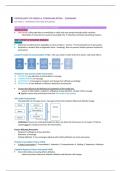PSYCHOLOGY OF MEDIA & COMMUNICATION – SUMMARY
LECTURE 1: INTRODUCTION AND INFLUENCE
CHAPTER 1: INFLUENCE Definition, history and model
INTRODUCTION
Advertising: calling attention to something or notify and warn people through public mediums.
- Information in many forms is used to accomplish this television dominant advertising medium.
BRIEF HISTORY OF INFLUENCE RESEARCH
Attitudes
Industrial revolution led to availability of more products + services increasing interest in persuasion.
Emphasis in research first on linguistics (form + meaning), then on process analysis (process involved in
persuasion)
Lasswell's model of communication (1948), "who says what in which channel to whom, with what effect,"
Hovland's 4-step process model of persuasion
1. ATTENTION: pay attention to information in message
2. UNDERSTANDING: of message
3. ACCEPTANCE: of message by recipient and change their attitude accordingly
4. RETENTION: of new attitude to influence behaviour permanently
Factors that influence the likelihood of completion of the model are:
- source of information, recipients’ willingness to pay attention, content of the message
Together these steps and factors form the Yale model of persuasion
Yale model of persuasion
- Characteristics of message source, message content and recipient influenced attitude change
- Limitations: focuses on motivated people but does not delve into the process or its impact fails to
explain how the recipient processes the information.
Factors Affecting Persuasion
- Recipient's willingness to pay attention
- Relevance of message.
- Existing attitudes new messages aligning with existing attitudes are more persuasive.
McGuire's Inoculation Theory (1964)
6 steps in persuasion: 1. Presentation 2. Attention 3. Comprehension 4. Yielding 5. Retention 6. Behavior
Cognitive Response Theory Greenwald (1968)
How information processing affects attitudes.
- Interim processes determine whether attitudes and behavior will change.
,Advertising and influence
AIDA model by Strong (1925)
How a recipient can be influenced
Attention, Interest, Desire, Action
- Extended by adding an 'S' for 'Satisfaction' (AIDAS) to ensure customer loyalty and repeat purchases.
Non-Sequential Process: 4 steps occur in parallel, and some steps may be skipped.
Assumes that people allocate time and attention to the information, which may not always be the case.
Passivity Assumption: views the recipient of advertising as passive, in contrast to most contemporary
psychological models of influence.
CONTENT OF THIS BOOK
, CHAPTER 2: ATTITUDES & BEHAVIOUR
INTRODUCTION
Influence attempts focus on changing attitudes, hoping this will alter behaviour.
Attitudes refer to evaluative responses ––positive or negative –– to a stimulus, the attitude object.
- Can be a person, organisation, situation, product or idea.
ATTITUDES, ATTITUDE FORMATION & BEHAVIOUR
Attitudes are hard to measure, because it is a latent construct: the actual attitude is not directly
observable, and has to be inferred from visible responses induced by the attitude object.
3 components of attitudes
1. Cognitive response: beliefs, opinions thoughts aroused by characteristics of the attitude object
2. Affective response: feelings, emotions feelings an object elicits, either expressed or in the form of a
physiological response. They are instinctive and often coincide with cognitions.
3. Behavioural response: actions, conduct things like consumer buying
Each of the 3 components – cognition, affect and behaviour – manifests an evaluative response
Components can contradict each other
Weight of underlying components can vary: some attitudes are primarily the product of the affective
response, other attitudes are more reasoned.
Behavior can influence cognitive and affective responses, and vice versa, leading to changes in attitudes.
- Behaviour is often a consequence of the cognitive and affective response (unbroken arrows)
- But behaviour can influence them too (dotted arrows)
REASONED AND INTUITIVE ATTITUDES
Distinction Between Reasoned and Instinctive Attitudes:
- Reasoned attitudes: conscious consideration of costs + benefits, in-depth evaluation of attitude object.
- Instinctive attitudes: less reasoned and involve superficial information processing.
Dual-process models describe 2 paths for information processing high or a low degree of thought






